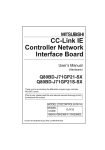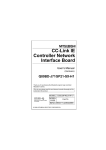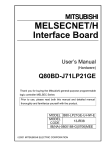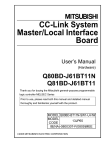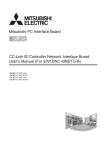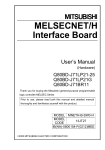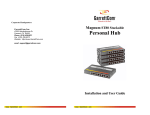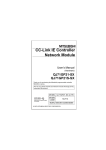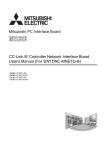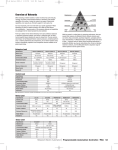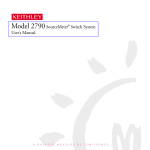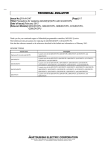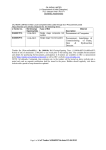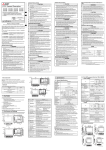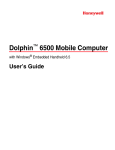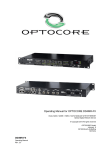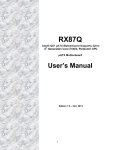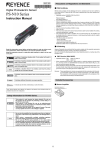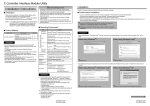Download CC-Link IE Controller Network Interface Board User`s Manual
Transcript
CC-Link IE Controller Network Interface Board User’s Manual (Hardware) Q80BD-J71GP21-SX Q80BD-J71GP21S-SX Thank you for purchasing the Mitsubishi program logic controller MELSEC-Q series. Prior to use, please read this and relevant manuals thorougly to fully understand the product. MODEL MNETG-B-SW1-H MODEL 13JY32 CODE IB(NA)-0800386-D(0809)MEE © 2007 MITSUBISHI ELECTRIC CORPORATION SAFETY PRECAUTIONS (Be sure to read these instructions before using the product.) Before using this product, read this manual and the relevant manuals introduced in this manual carefully and handle the product correctly with full attention to safety. Note that these precautions apply only to this product. Refer to the user's manual of your CPU module for safety precautions on programmable controller systems. In this manual, the safety instructions are ranked as "DANGER" and "CAUTION". DANGER Indicates that incorrect handling may cause hazardous conditions, resulting in death or severe injury. CAUTION Indicates that incorrect handling may cause hazardous conditions, resulting in minor or moderate injury or property damage. Note that failure to observe the CAUTION level instructions may also lead to serious results depending on the circumstances. Be sure to observe the instructions of both levels to ensure personal safety. Please store this manual in a safe place for future reference. This manual must be forwarded to the end user. A-1 [Installation Precautions] DANGER Do not touch connectors while current is applied. Doing so may cause an electric shock or malfunction. Be sure to shut off all phases of the external power supply used by the system before installing the CC-Link IE Controller Network board to or removing it from the personal computer. Failure to do so may cause an electric shock or damage to the product. CAUTION Use the CC-Link IE Controller Network board in an environment that meets the general specifications provided in this manual. Using it in an environment that does not meet the general specifications may result in an electric shock, fire, malfunction, damage to or deterioration of the product. Securely insert the CC-Link IE Controller Network board into the PCI bus slot following the board installation instruction of the personal computer. Incorrect insertion of the CC-Link IE Controller Network board may lead to a malfunction, failure or drop of the board. When installing the CC-Link IE Controller Network board, take care not to get injured by an implemented component or a surrounding member. Before handling the CC-Link IE Controller Network board, touch a grounded metal object to discharge the static electricity from the human body. Failure to do so may cause a failure or malfunction of the CC-Link IE Controller Network board. Handle the CC-Link IE Controller Network board in a place where static electricity will not be generated. Failure to do so may cause a failure or malfunction. Do not directly touch a conductive part of the CC-Link IE Controller Network board. Doing so may cause a failure or malfunction. Fix the CC-Link IE Controller Network board by tightening the board-fixing screws within the specified torque range. Insufficient tightening may result in a malfunction. The CC-Link IE Controller Network board is included in an antistatic envelope. When storing or transporting it, be sure to put it in the antistatic envelope. Failure to do so may cause a failure or malfunction. Do not disassemble or remodel the CC-Link IE Controller Network board. Doing so may result in a failure, malfunction, injuries and/or a fire. Do not drop or apply a strong impact to the CC-Link IE Controller Network board. Doing so may cause a failure or malfunction. A-2 [Wiring Precautions] DANGER Be sure to shut off all phases of the external power supply used by the system before installing the CC-Link IE Controller Network board or starting wiring. Failure to do so may cause an electric shock, damage to the product or malfunction. Before applying power to operate the system after installation of the CC-Link IE Controller Network board and wiring, be sure to put the cover on the module. Failure to do so may result in an electric shock. CAUTION Special skills and tools are required to connect the communication cable to the connector plug, which is an exclusive product. When purchasing it, please consult your local Mitsubishi representative. Incomplete connection can result in a short, fire or malfunction. Securely plug the communication cable to the connector of the CC-Link IE Controller Network board. Then, check for any incomplete connection. Poor contact may cause an erroneous input or output. Place the communication cables and external power supply cable connected to the CC-Link IE Controller Network board in a duct or clamp them. If not, dangling cables may swing or inadvertently be pulled, resulting in damage to the board or cables or malfunctions due to poor cable contact. When disconnecting the cable from the CC-Link IE Controller Network board, do not pull the cable part. Pulling the cable that is still connected to the CC-Link IE Controller Network board may damage the board and/or cable, or cause a malfunction due to poor contact. Prevent foreign matter such as chips or wiring debris from getting into the personal computer. Failure to do so can result in a fire, failure or malfunction. Verify the rated voltage and pin-out, and connect the external power supply cable properly. Connecting a power supply with a different voltage rating, imperfect cable crimping or faulty wiring may cause a fire or failure. Use a specified tool for crimping of the cable and contacting pin. Imperfect crimping may cause a malfunction. Verify the pin-out and fully insert the crimped contacting pin into the connector. Imperfect insertion may cause a failure or malfunction. A-3 [Wiring Precautions] CAUTION Insert the wired external power supply cable into the external power supply cable connector until a click is heard. Imperfect insertion may cause a failure or malfunction. Keep the external power supply cable away from the main circuit cable, power cables and/or the load cables for any other than programmable controllers. Ensure a distance of 100 mm (3.94 in.) between them. Failure to do so may result in a malfunction due to noise, surge or induction. Always ground the personal computer to the protective ground conductor. Failure to do so may cause a malfunction [Disposal Precautions] CAUTION When disposing of this product, treat it as industrial waste. A-4 Revisions * The manual number is given on the bottom right of the cover. Print Date Apr., 2007 *Manual Number IB(NA)-0800386-A Oct., 2007 IB(NA)-0800386-B Jan., 2008 IB (NA)-0800386-C Sep., 2008 IB (NA)-0800386-D Revision First edition Correction Chapter 5, Section 7.2, Chapter 8 Correction SAFETY PRECAUTIONS, Manual, Chapter 1, Chapter 2, Chapter 3, Chapter 4, Chapter 5, Chapter 6, Chapter 7 Correction Chapter 2 This manual confers no industrial property rights or any rights of any other kind, nor does it confer any patent licenses. Mitsubishi Electric Corporation cannot be held responsible for any problems involving industrial property rights which may occur as a result of using the contents noted in this manual. © 2007 MITSUBISHI ELECTRIC CORPORATION A-5 CONTENTS 1. OVERVIEW..................................................................................................... 1 2. PERFORMANCE SPECIFICATIONS ............................................................. 2 3. HANDLING ..................................................................................................... 4 3.1 Handling precautions ................................................................................ 4 3.2 Installation environment............................................................................ 6 4. PART NAMES................................................................................................. 7 5. EMC AND LOW VOLTAGE DIRECTIVE ...................................................... 10 5.1 Requirements for conformance to EMC Directive .................................. 10 5.1.1 Standards applicable to the EMC Directive..................................... 11 5.1.2 Installing devices in the control panel ............................................. 12 5.1.3 Noise filter (power supply line filter) ................................................ 14 5.2 Requirements for conformance to Low Voltage Directive ...................... 14 6. WIRING......................................................................................................... 15 6.1 Optical fiber cable................................................................................... 18 6.2 External power supply cable................................................................... 19 7. INSTALLING SOFTWARE PACKAGES....................................................... 21 7.1 Installation procedures ........................................................................... 21 7.2 Icons to be Registered............................................................................ 23 8. EXTERNAL DIMENSIONS ........................................................................... 24 A-6 Manual The following is the manual relevant to this product. Please purchase it if necessary. Relevant Manuals Manual Number (Model Code) Manual Name MELSECNET/G Network System Reference Manual (Controller Network) This manual explains the system configuration, performance specification, functions, handling and wiring instructions, and troubleshooting of the CC-Link IE Controller network system. (Sold separately) CC-Link IE Controller Network Interface Board User's Manual (For SW1DNC-MNETG-B) This manual explains the system configuration, software package installation and uninstallation, operating method for utilities, accessible ranges and devices, and troubleshooting of the CC-Link IE Controller Network board. (Sold separately) A-7 SH-080668ENG (13JV16) SH-080691ENG (13JZ02) 1. OVERVIEW This manual explains the handling of the Q80BD-J71GP21(S)-SX CCLink IE Controller Network interface board (hereinafter referred to as CC-Link IE Controller Network board). The CC-Link IE Controller Network board can be used as a control station or normal station in the CC-Link IE Controller network system. The packing list of the CC-Link IE Controller Network board is given below. Quantity Item Q80BD-J71GP21-SX Q80BD-J71GP21S-SX 1 — — 1 — 1 1 1 1 1 Software license agreement 1 1 Software registration card 1 1 Q80BD-J71GP21-SX CC-Link IE Controller Network interface board Q80BD-J71GP21S-SX CC-Link IE Controller Network interface board Connector set (for external power supply cable) CC-Link IE Controller Network Interface Board User's Manual (Hardware) SW1DNC-MNETG-B CC-Link IE Controller Network software package (CDROM)*1 *1 The CD-ROM contains the User's Manual in PDF format. 1 2. PERFORMANCE SPECIFICATIONS Performance specifications of the CC-Link IE Controller Network board are shown below. Q80BD-J71GP21-SX, Q80BD-J71GP21S-SX Item LB Max. link points LW per network LX LY LB Max. link points LW per station LX LY Transient transmission capacity Communications speed Number of stations per network Connection cable Overall cable distance Min. Station-tostation distance Max. Max. number of networks Max. number of groups Transmission path Communication method Synchronization method Encoding method Transfer format Error control system RAS functions Transient transmission Specification Q80BD-J71GP21-SX Q80BD-J71GP21S-SX 32K points (32768 points, 4K bytes) 128K points (131072 points, 256K bytes) 8K points (8192 points, 1K byte) 8K points (8192 points, 1K byte) 16K points (16384 points, 2K bytes) 16K points (16384 points, 32K bytes) 8K points (8192 points, 1K byte) 8K points (8192 points, 1K byte) Up to 1920 bytes 1G bps 120 stations (Control station: 1; Normal station: 119) Optical fiber cable (Multi-mode fiber) 66000 m (When 120 stations are connected) 2m 550 m (Core/clad = 50/125 ( m)) 239 32 Duplex loop Token ring method Flag synchronization (Frame synchronization) 8B10B Ethernet II FCS (Frame Check Sequence, CRC32 of the frame, Ethernetcompliant) Loop back function by error detection and cable disconnection, System-down prevention by control station switching, Error detection by link special relays and link special registers, etc. N: N communications 2 Item Number of boards that can be installed Installation slot Occupied slots Voltage Current Specification Q80BD-J71GP21-SX Q80BD-J71GP21S-SX Up to 4*1 PCI bus slot (Half size) or PCI-X bus slot (Half size) 1 slot 20.4 V to 31.2 V DC 0.27 A Connector Applicable cable size External power Allowable *2 supply momentary power failure time Noise durability PCI bus performance 5 V DC Internal current consumption Weight *1 Connector set (Accessory) 0.50 to 1.25 mm2 [AWG20-16] (No external power supply) 1ms (level PS1) Noise voltage: 500vp-p Noise width: 1 s (By the noise simulator with noise frequency 25 to 60Hz) Bus width: 32 bit Bus frequency: 33MHz Bus voltage: 5V or 3.3 V DC (Universal PCI compliance) 0.88 A 0.88 A 0.12 kg 0.14 kg This indicates the number of CC-Link IE Controller Network boards that can be installed to a personal computer, not including any other boards such as MELSECNET/H boards. Note that it cannot exceed the number of physical PCI slots of the personal computer. *2 Use the power complies with CLASS2. 3 3. HANDLING This section explains precautions for handling and installation environment of the CC-Link IE Controller Network board. 3.1 Handling precautions The following explains precautions for handling the CC-Link IE Controller Network board. DANGER Do not touch connectors while current is applied. Doing so may cause an electric shock or malfunction. Be sure to shut off all phases of the external power supply used by the system before installing the CC-Link IE Controller Network board to or removing it from the personal computer. Failure to do so may cause an electric shock or damage to the product. 4 CAUTION Securely insert the CC-Link IE Controller Network board into the PCI bus slot following the board installation instruction of the personal computer. Incorrect insertion of the CC-Link IE Controller Network board may lead to a malfunction, failure or drop of the board. When installing the CC-Link IE Controller Network board, take care not to get injured by an implemented component or a surrounding member. Before handling the CC-Link IE Controller Network board, touch a grounded metal object to discharge the static electricity from the human body. Failure to do so may cause a failure or malfunction of the CC-Link IE Controller Network board. Handle the CC-Link IE Controller Network board in a place where static electricity will not be generated. Failure to do so may cause a failure or malfunction. Do not directly touch a conductive part of the CC-Link IE Controller Network board. Doing so may cause a failure or malfunction. Fix the CC-Link IE Controller Network board by tightening the board-fixing screws within the specified torque range. Insufficient tightening may result in a malfunction. The CC-Link IE Controller Network board is included in an antistatic envelope. When storing or transporting it, be sure to put it in the antistatic envelope. Failure to do so may cause a failure or malfunction. Do not disassemble or remodel the CC-Link IE Controller Network board. Doing so may result in a failure, malfunction, injuries and/ or a fire. Do not drop or apply a strong impact to the CC-Link IE Controller Network board. Doing so may cause a failure or malfunction. Prevent foreign matter such as chips or wiring debris from getting into the personal computer. Failure to do so can result in a fire, failure or malfunction. When disposing of this product, treat it as industrial waste. For the tightening torque of the CC-Link IE Controller Network boardfixing screws, refer to the manual supplied with the personal computer. 5 3.2 Installation environment For installation of the personal computer in which the CC-Link IE Controller Network board is installed, refer to the manual for the personal computer. CAUTION Use the CC-Link IE Controller Network board in an environment that meets the general specifications provided in this manual. Using it in an environment that does not meet the general specifications may result in an electric shock, fire, malfunction, damage to or deterioration of the product. Always ground the personal computer to the protective ground conductor. Failure to do so may cause a malfunction. 6 4. PART NAMES This section explains each part name and setting of the CC-Link IE Controller Network board. (1) Q80BD-J71GP21-SX 1) RUN ERR. SD IN RD 2) OUT BD808C 317G51 (2) Q80BD-J71GP21S-SX E.PW E.PW RUN ERR. 4) 3) 1) SD IN RD 2) OUT E.PW +24VDC 24G NC BD808C 317G51 7 No. Name Indicator LED 1) RUN ERR. SD RD Description Indicates the operating status of the CC-Link IE Controller Network board. The display format has three types: normal mode, error mode and channel number confirmation. (1) Normal mode When the RUN LED is OFF or ON, the LED display becomes normal mode. If a communication error occurs in the mode, determine the error in Select station network device status display on the "CC-Link IE Controller Network diagnostics result" screen of the CC IE Control utility. For the Select station network device status display, refer to "CC-Link IE Controller Network Interface Board User's Manual (For SW1DNC-MNETG-B)". LED name Status Description A WDT error occurred or the board OFF is being reset. RUN ON In normal operation OFF Data has not been sent. SD ON During data transmission OFF Data has not been received. RD ON During data reception OFF No error ERR. ON Error (2) Error mode When the RUN LED is flashing, the LED display becomes error mode. If an error occurs in the mode, check the error description on the Event Viewer screen. LED name Status Description Indicates the display format is in Flashing error mode. RUN ON Indicates the display format is not in OFF error mode. OFF — SD ON — OFF No driver response error RD ON A driver response error occurred. OFF No PCI bus error ERR. ON A PCI bus error occurred. (3) Channel number confirmation mode This mode is for checking the channel No. of each board. The LED displays the channel No. assigned to each board. For details, refer to "CC-Link IE Controller Network Interface Board User's Manual (For SW1DNC-MNETG-B)". 8 No. Name Description Connector for connecting optical fiber cable (1) The cable terminal is as shown below. IN Reverse loop transmission 2) IN Forward loop reception Optical fiber cable connector OUT Forward loop transmission OUT Reverse loop reception External power supply LED 3) E.PW (2) For wiring of an optical fiber cable, refer to "CC-Link IE Controller Network Interface Board User's Manual (For SW1DNC-MNETG-B)". Indicates the status of external power supply. LED name Status Description External power supply is not OFF supplied. E.PW External power supply is being ON supplied. Connector for connecting external power supply cable The cable terminal is as shown below. 4) External power supply cable connector (Board top) 24V 24G E.PW 9 5. EMC AND LOW VOLTAGE DIRECTIVE For the products sold in European countries, the conformance to the EMC Directive, which is one of the European Directives, has been a legal obligation since 1996. Also, conformance to the Low Voltage Directive, another European Directive, has been a legal obligation since 1997. Manufacturers who recognize their products must conform to the EMC and Low Voltage Directives are required to declare that their products conform to these Directives and put a "CE mark" on their products. 5.1 Requirements for conformance to EMC Directive The EMC Directive specifies that products placed on the market must "be so constructed that they do not cause excessive electromagnetic interference (emissions) and are not unduly affected by electromagnetic interference (immunity) ". The applicable products are requested to meet these requirements. The sections 5.1.1 through 5.1.3 summarize the precautions on conformance to the EMC Directive of the machinery constructed using the CC-Link IE Controller Network board. The details of these precautions has been prepared based on the control requirements and the applicable standards. However, we will not assure that the overall machinery manufactured according to these details conforms to the above-mentioned directives. The final decision on the method for the EMC Directive conformance and the application must be made by the manufacturer of the machinery. 10 5.1.1 Standards applicable to the EMC Directive The standards applicable to the EMC Directive are listed below. All test items were tested by installing each device on a personal computer bearing a CE certification logo. Specification EN61131-2: 2003 *1 Test item Test details Standard value EN61000-6-4 Radiated noise Measures electromagnetic emissions from the product. 30M-230MHz QP: 30 dB V/m (30 m in measurement range)*1 230M-1000MHz QP: 37 dB V/m (30 m in measurement range)*1 EN61000-6-4 Conducted noise Measures electromagnetic emissions from the product to the power line. 150k-500kHz QP: 79 dB, Mean: 66 dB*1 500k-30MHz QP: 73 dB, Mean: 60 dB*1 EN61000-4-2 Electrostatic immunity Immunity test in which static 4 kV Contact discharge electricity is applied 8 kV Aerial discharge to the cabinet of the equipment. EN61000-4-4 Electrical fast transient/ burst immunity Immunity test in Power line: 2 kV which a burst noise Data communication: 1 kV is applied to a power Digital/Analog I/O (shielded): 1 kV line and signal line. EN61000-4-3 Radiated electromagnetic field immunity (AM modulation) Immunity test in which a field is irradiated to the product. 10 V/m, 26-1000 MHz, 80%AM modulation@1 kHz EN61000-4-6 Conducted disturbances immunity Immunity test in which a high frequency noise is applied to a power line and signal line. 3V EN61000-4-5 Surge immunity Immunity test in which a lightning surge is applied to a power line and signal line. Power line: 2 kV (CM), 1 kV (DM) Data communication (shielded): 1 kV (CM) Digital/Analog I/O (shielded): 1 kV (CM) QP: Quasi-peak value, Mean: Mean value 11 5.1.2 Installing devices in the control panel Installing devices in the control panel has a considerable effect, not only securing safety but also shielding the noise generated from the personal computer in the control panel. (1) Control panel (a) Use a conductive control panel. (b) When attaching the control panel's top plate or base plate, mask painting and weld so that good surface contact can be made between the panel and plate. (c) To ensure good electrical contact with the control panel, mask the paint on the installation bolts of the inner plate in the control panel so that contact between surfaces can be ensured over the widest possible area. (d) Ground the control panel with a thick wire so that a low impedance connection to ground can be ensured even at high frequencies. (e) Holes made in the control panel must be 10 cm (3.94 in.) diameter or less. If the holes are 10 cm (3.94 in.) or larger, radio frequency noise may be emitted. In addition, because radio waves leak through a clearance between the control panel door and the main unit, reduce the clearance as much as practicable. The leakage of radio waves can be suppressed by the direct application of an EMI gasket on the paint surface. Maker name Series type KITAGAWA INDUSTRIES CO., LTD. US series ZIPPERTUBING (JAPAN) LTD. 71TS series SEIWA ELECTRIC MFG CO., LTD. E02S A Our tests have been carried out on a panel having the damping characteristics of 37 dB max. and 30 dB mean (measured by 3 m method with 30 to 300MHz). 12 (2) Connection of power and ground cable The power supply cable and ground cable for a personal computer should be laid out as follows: (a) Provide a grounding point near the power supply of personal computer. Ground the FG (frame ground) terminal of the personal computer and the SLD (shield) terminal of the CCLink IE Controller Network board with the thickest and shortest grounding wire (wire for grounding) possible (about 30 cm (11.81 in.) or less in length). Since the FG and SLD terminals function to ground the noise generated in the personal computer, it is necessary to ensure the lowest possible impedance. As the wires are used to relieve the noise, the wire itself contains a large amount of noise and thus short wiring prevents from functioning as an antenna. (b) Twist the ground cable leading to the ground point with the power supply cable. By twisting it with the ground cable, the noise leaking from the power supply cable may be grounded at a higher rate. However, twisting the power supply cable with the ground cable may not be necessary if a noise filter is installed on the power supply cable. 13 5.1.3 Noise filter (power supply line filter) A noise filter is a component which has an effect on conducted noise. It is not required to fit the noise filter to the power supply line, but fitting it can further suppress noise. (The noise filter has the effect of reducing conducted noise of 10MHz or less.) The precautions required when installing a noise filter are described below. (1) Do not bundle the wires on the input side and output side of the noise filter. When they are bundled, the output side noise will induct into the input side wires. Input side (power supply side) Input side (power supply side) Introduction Filter Filter Output side (device side) (a) The noise will induct into input side when the input and output wires are bundled. Output side (device side) (b) Separate the input and output wires. (2) Ground the ground terminal of the noise filter to the control panel using as short wiring as possible (about 10 cm (3.94 in.)). Remarks Reference noise filters are shown below. Noise filter type FN343-3/01 FN660-6/06 ZHC2203-11 Maker name SCHAFFNER TDK Rated current 3A 6A 3A Rated voltage 250 V 5.2 Requirements for conformance to Low Voltage Directive The CC-Link IE Controller Network board is out of the requirement for conformance to the Low Voltage Directive, since it does not use the power supply in the range of 50 to 1000V AC and 75 to 1500V DC. 14 6. WIRING This section explains precautions for connecting cables to the CC-Link IE Controller Network board. (1) Precautions for general wiring DANGER Be sure to shut off all phases of the external power supply used by the system before installing the CC-Link IE Controller Network board or starting wiring. Failure to do so may cause an electric shock, damage to the product or malfunction. Before applying power to operate the system after installation of the CC-Link IE Controller Network board and wiring, be sure to put the cover on the module. Failure to do so may result in an electric shock. CAUTION When disconnecting the cable from the CC-Link IE Controller Network board, do not pull the cable part. Pulling the cable that is still connected to the CC-Link IE Controller Network board may damage the board and/or cable, or cause a malfunction due to poor contact. Prevent foreign matter such as chips or wiring debris from getting into the personal computer. Failure to do so can result in a fire, failure or malfunction. Always ground the personal computer to the protective ground conductor. Failure to do so may cause a malfunction. 15 (2) Precautions for communication cable wiring CAUTION Special skills and tools are required to connect the communication cable to the connector plug, which is an exclusive product. When purchasing it, please consult your local Mitsubishi representative. Incomplete connection can result in a short, fire or malfunction. Securely plug the communication cable to the connector of the CC-Link IE Controller Network board. Then, check for any incomplete connection. Poor contact may cause an erroneous input or output. Place the communication cables connected to the CCLink IE Controller Network board in a duct or clamp them. If not, dangling cables may swing or inadvertently be pulled, resulting in damage to the board or cables or malfunctions due to poor contact. Remarks For optical fiber cables, refer to the "MELSECNET/G Network System Reference Manual (Controller Network)". 16 (3) Precautions for external power supply cable wiring CAUTION Verify the rated voltage and pin-out, and connect the external power supply cable properly. Connecting a power supply with a different voltage rating, imperfect cable crimping or faulty wiring may cause a fire or failure. Use a specified tool for crimping of the cable and contacting pin. Imperfect crimping may cause a malfunction. Verify the pin-out and fully insert the crimped contacting pin into the connector. Imperfect insertion may cause a failure or malfunction. Insert the wired external power supply cable into the external power supply cable connector until a click is heard. Imperfect insertion may cause a failure or malfunction. Keep the external power supply cable away from the main circuit cable, power cables and/or the load cables for any other than programmable controllers. Ensure a distance of 100 mm (3.94 in.) between them. Failure to do so may result in a malfunction due to noise, surge or induction. Place the external power suppply cables connected to the CC-Link IE Controller Network board in a duct or clamp them. If not, dangling cables may swing or inadvertently be pulled, resulting in damage to the board or cables or malfunctions due to poor contact. Remarks For details of the wiring method, refer to "CC-Link IE Controller Network Interface Board User's Manual (For SW1DNC-MNETG-B)". 17 6.1 Optical fiber cable The following explains precautions for connecting the optical fiber cables with the Q80BD-J71GP21-SX and Q80BD-J71GP21S-SX. (1) Precautions for connection (a) Use the dedicated optical fiber cable shown below for the controller network system. Type Model name (maker) Multi-mode fiber (GI) QG series (Mitsubishi electric system & service Co., Ltd.) (b) When connecting an optical fiber cable to the Q80BDJ71GP21-SX and Q80BD-J71GP21S-SX, the cable bend radius is restricted. For details, check the specifications of the cable used. (c) When laying the optical fiber cables, do not touch the fiber cores of the cable-side and board-side connectors, and protect them from dirt and dust. If oil from the hand, dirt or dust is attached to the core, it can increase transmission loss, causing a problem in data link. (d) When connecting or disconnecting an optical fiber cable, hold the connector part of the cable. (e) Make a full connection between the cable-side and board-side connectors until a "click" can be heard. (f) When installing the Q80BD-J71GP21-SX or Q80BDJ71GP21S-SX to the personal computer, secure a space of around 10 mm (0.39 in.) to the right and left of the optical connector. Depending on the adjacent boards and installing slot position, connecting/disconnecting the optical cable may be difficult. In this case, use the following dedicated tool. Model name SCT-SLM Maker Mitsubishi electric system & service Co., Ltd. CC-Link IE Controller Network board Board-side connector Cable-side connector Connector hook 18 6.2 External power supply cable This section explains the method for connecting external power supply cable to the Q80BD-J71GP21S-SX. (1) Parts and tools required for external power supply cable The following parts and tools are required for making external power supply cable. (a) Connector set (accessories) Check that the following parts are included with the attached connector set. Type Connector Contact Model name 1-178288-3 175218-2 Applicable wire size — AWG#20-16 Quantity 1 3 (Spare 1) (b) Cable Use an external power supply cable with heat-resistant vinyl sheath of 0.5 to 1.25 mm2 [AWG 20 to 16]. (c) Tool Use the following specified crimp tools. Model 91558-1 1762956-1 Applicable wire size AWG#20-16 Inquiry Tyco Electronics (2) Making external power supply cable (a) Crimping a contacting pin Using a crimp tool, crimp the cable and contacting pin. Set the contacting pin and cable in the grooves of the crimp tool, squeeze the handle, and make them stick together tightly. For details of the crimp, refer to the instruction of the tool. A strip length of the cable should be 5 to 7 mm (1/5 to 2/7 in.) (b) Check for a crimp Check if the cable (including a part of the sheath) is evenly crimped to the contacting pin. If the cable part is crimped but not the sheath part or the cable is stuck out, the cable cut or a malfunction may result. 19 Contacting pin Cable (c) Connecting to the connector According to the following pin-out, fully insert the crimped cable to the connector until a click is heard. Pin No. 1 2 3 Description 24V 24G Open Connector Contacting pin 24V 24G (3) Connecting external power supply cable to the board Properly insert the wired external power supply cable to the external power supply cable connector of the Q80BD-J71GP21SSX until a click is heard. Keep the cable away from the main circuit cable, power cables and/ or the load cables for any other than programmable controllers. Ensure a distance of 100 mm (3.94 in.) between them. POINT Be sure to twist the external power supply cable. 20 7. INSTALLING SOFTWARE PACKAGES This chapter explains about installing the software packages and icons to be registered. For the uninstallation method, refer to "CC-Link IE Controller Network Interface Board User's Manual (For SW1DNC-MNETG-B)". 7.1 Installation procedures For details of the installation procedure, refer to "CC-Link IE Controller Network Interface Board User's Manual (For SW1DNC-MNETG-B)". POINT (1) (2) (3) (4) (5) (6) Multi-processor personal computers cannot be used because the driver does not support them. For details of the operating environment, refer to "CC-Link IE Controller Network Interface Board User's Manual (For SW1DNC-MNETG-B)". Log on as a user having administrator authority. Cancel all applications registered in Startup and install the driver after restarting Windows . Make sure to close other applications running on Windows (including resident software such as antivirus software) before installation. If the installation failed, uninstall the software package if possible. When reinstalling the software package, do so after uninstalling the current software package and restarting the personal computer. 21 START Power OFF the personal computer. Install the CC-Link IE Controller Network board to the personal computer. Power ON the personal computer. Install SW1DNC-NMETG-B (driver). Install SW1DNC-NMETG-B (utility). END 22 7.2 Icons to be Registered After installing the software packages, the icons shown below are registered in [MELSEC], selected from [Start] - [Program]. Remarks When using Windows XP Professional/Windows XP Home Edition/ Windows Vista *1, the following icons are registered in [Start] - [All Programs] - [MELSEC]. Icon *1 Utility name Description CC IE Control utility Starts CC IE Control utility. Device Monitor Utility Starts Device monitor utility. MELSEC Data Link Function HELP Starts HELP for the data link function. Generic term for Microsoft Microsoft Windows Vista Microsoft Windows Vista Microsoft Windows Vista Microsoft Windows Vista Windows Vista Home Basic Operating System, Home Premium Operating System, Business Operating System, Ultimate Operating System, and Enterprise Operating System. 23 8. EXTERNAL DIMENSIONS (1) Q80BD-J71GP21-SX 174.5 (6.87) SD IN RD 121 (4.76) RUN ERR. 107 (4.21) 98.5 (3.88) 181 (7.13) 168 (6.61) OUT BD808C 317G51 18.5 (0.73) (Unit: mm (inch)) 24 (2) Q80BD-J71GP21S-SX 174.5 (6.87) 181 (7.13) 168 (6.61) E.PW RD 121 (4.76) RUN ERR. SD IN 107 (4.21) 98.5 (3.88) E.PW OUT E.PW +24VDC 24G NC BD808C 317G51 18.5 (0.73) (Unit: mm (inch)) Microsoft and Windows are registered trademarks of Microsoft Corporation in the United States and other countries. Ethernet is a registered trademark of Xerox.co.ltd in the United States. Other company names and product names used in this document are trademarks or registered trademarks of respective companies. 25 Warranty Mitsubishi will not be held liable for damage caused by factors found not to be the cause of Mitsubishi; machine damage or lost profits caused by faults in the Mitsubishi products; damage, secondary damage, accident compensation caused by special factors unpredictable by Mitsubishi; damages to products other than Mitsubishi products; and to other duties. For safe use • This product has been manufactured as a general-purpose part for general industries, and has not been designed or manufactured to be incorporated in a device or system used in purposes related to human life. • Before using the product for special purposes such as nuclear power, electric power, aerospace, medicine or passenger movement vehicles, consult with Mitsubishi. • This product has been manufactured under strict quality control. However, when installing the product where major accidents or losses could occur if the product fails, install appropriate backup or failsafe functions in the system. Country/Region Sales office/Tel U.S.A Mitsubishi Electric Automation Inc. 500 Corporate Woods Parkway Vernon Hills, IL 60061 Tel : +1-847-478-2100 Brazil MELCO-TEC Rep. Com.e Assessoria Tecnica Ltda. Rua Correia Dias, 184, Edificio Paraiso Trade Center-8 andar Paraiso, Sao Paulo, SP Brazil Tel : +55-11-5908-8331 Germany Mitsubishi Electric Europe B.V. German Branch Gothaer Strasse 8 D-40880 Ratingen, GERMANY Tel : +49-2102-486-0 U.K Mitsubishi Electric Europe B.V. UK Branch Travellers Lane, Hatfield, Herts., AL10 8XB,UK Tel : +44-1707-276100 Italy Mitsubishi Electric Europe B.V. Italian Branch Centro Dir. Colleoni, Pal. Perseo-Ingr.2 Via Paracelso 12, 20041 Agrate B., Milano, Italy Tel : +39-039-6053344 Spain Mitsubishi Electric Europe B.V. Spanish Branch Carretera de Rubi 76-80 08190 Sant Cugat del Valles, Barcelona, Spain Tel : +34-93-565-3131 France Mitsubishi Electric Europe B.V. French Branch 25 Boulevard des Bouvets, F-92741 Nanterre Cedex, France TEL: +33-1-5568-5568 South Africa Circuit Breaker Industries LTD. Tripswitch Drive, Elandsfontein Gauteng, South Africa Tel : +27-11-928-2000 Country/Region Sales office/Tel Hong Kong Ryoden Automation Ltd. 10th Floor, Manulife Tower, 169 Electric Road, North Point, HongKong Tel : +852-2887-8870 China Ryoden Automation Shanghai Ltd. 3F Block5 Building Automation Instrumentation Plaza 103 Cao Bao Rd. Shanghai 200233 China Tel : +86-21-6120-0808 Taiwan Setsuyo Enterprise Co., Ltd. 6F., No.105 Wu-Kung 3rd.RD, Wu-Ku Hsiang, Taipei Hsine, Taiwan Tel : +886-2-2299-2499 Korea HAN NEUNG TECHNO CO.,LTD. 1F Dong Seo Game Channel Bldg., 660-11, Deungchon-dong Kangsec-ku, Seoul, Korea Tel : +82-2-3660-9552 Singapore Mitsubishi Electric Asia Pte, Ltd. 307 Alexandra Road #05-01/02, Mitsubishi Electric Building Singapore 159943 Tel : +65-6473-2308 Thailand F. A. Tech Co.,Ltd. 898/28,29,30 S.V.City Building,Office Tower 2, Floor 17-18 Rama 3 Road, Bangkpongpang, Yannawa, Bangkok 10120 Tel : +66-2-682-6522 Indonesia P.T. Autoteknindo SUMBER MAKMUR Jl. Muara Karang Selatan Block a Utara No.1 Kav. No.11 Kawasan Industri/ Pergudangan Jakarta - Utara 14440 Tel : +62-21-663-0833 India Messung Systems Put,Ltd. Electronic Sadan NO:111 Unit No15, M.I.D.C BHOSARI,PUNE-411026, India Tel : +91-20-712-2807 Australia Mitsubishi Electric Australia Pty. Ltd. 348 Victoria Road, PostalBag, No 2, Rydalmere, N.S.W 2116, Australia Tel : +61-2-9684-7777 HEAD OFFICE : 1-8-12, OFFICE TOWER Z 14F HARUMI CHUO-KU 104-6212, JAPAN NAGOYA WORKS : 1-14, YADA-MINAMI 5-CHOME, HIGASHI-KU, NAGOYA, JAPAN When exported from Japan, this manual does not require application to the Ministry of Economy, Trade and Industry for service transaction permission. Specifications subject to change without notice. Printed in Japan on recycled paper.


































